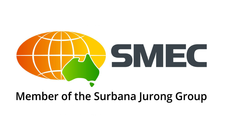SMEC South Africa completes Park Station sewer upgrade
| SMEC South Africa completes Park Station sewer upgrade | 19.03 KB | Download | |
| A new sewer manhole in-between the railway tracks at Park Station. | 2.12 MB | Download | |
| Manhole construction on the Park Station platforms. Railway lines had to be operational at all times. | 2.14 MB | Download | |
| Pulling the new HDPE pipe (for the HDD line perpendicular to the tracks) into the drilled hole. | 1.58 MB | Download | |
| Railway platforms where HDD was carried out perpendicular to the tracks. The upper left excavation is the connecting manhole. | 7.18 MB | Download |
The project was an important showcase of SMEC South Africa’s total solutions package, from initial investigation to preliminary design report, construction drawings and overseeing the entire construction process.
“We opted for Horizontal Directional Drilling (HDD) for the refurbishment of the Park Station sewer network. This is a steerable trenchless method of installing underground pipes whenever trenching or excavating is not practical,” explains Meghan Brinkley, Professional Engineer, Asset Management and Advisory Services, SMEC South Africa.
“Conventional trenching techniques were not an option as the line that had to be replaced ran underneath the railway lines at Park Station. HDD has a minimal impact on the surrounding area, making it ideal for a range of applications and soil conditions,” notes Brinkley.
The HDD process involves three main stages: drilling a pilot hole, enlarging (pre-reaming) the pilot hole and finally the pull-back installation of the carrier pipe. Uncontrolled or unguided drilling can result in damage or unforeseen complications, meaning it is vital to track the drilling head when drilling the pilot hole on the designed path.
“Another important consideration is to maintain the designed slopes along the drilled path. The contractor utilised the iTrack system from Radiodetection to locate the bore head and keep it on track, providing the operator with accurate data on tilt angle, roll position, depth, remote left/right steering and alarm conditions,” elaborates Brinkley. The borehole is supported by a bentonite drilling fluid that prevents it from collapsing.
Soil conditions are critical, as voids or incomplete rock layers can render HDD impractical. It also affects the type of heads used in the pilot-hole process. “During the geotechnical investigation, GPR (Ground Penetrating Radar) revealed no anomalies along the designed path,” confirms Brinkley.
HDD was used to drill a new 160 mm Ø HDPE pipeline diagonally underneath the train tracks at Park Station in order to connect existing manholes with the new main-line manhole constructed on PF11 (Platform) and PF12. A new 250 mm Ø HDPE line was also drilled from the new manhole on PF11 to PF12 to the municipal connection manhole under Harrison Avenue Bridge.
In order to prioritise effective maintenance, the new reticulation network was structured for easy accessibility. SMEC South Africa’s investigation called for repairs on existing sewer pipes inside sewer ducts. In addition, inspection eyes had to be installed and joints adequately sealed.
All sewerage flowing from the aboveground shopping outlets and toilets between PF1 to PF10 is now collected by four 110 mm diameter uPVC pipelines, supported by a service tray for easy access and visible inspection.
“It is important that these pipelines run parallel to the train tracks and do not cross the train power lines at any point,” stresses Brinkley. Four 110 mm Ø uPVC pipelines drop vertically and offload sewerage into platform manholes, as well as a new manhole constructed on PF9 to PF10. “Going forward, continued maintenance will ensure effective operation of the sewer network for years to come,” concludes Brinkley.
Ends
Notes to the editor
To download hi-res images for this release, please visit http://media.ngage.co.za and click the SMEC South Africa link to view the company’s press office.
About SMEC South Africa
SMEC is a professional services firm with Australian origins and a global footprint that provides high-quality consultancy services on major infrastructure projects. SMEC has over 5 100 employees and an established network of more than 70 offices in Australia, Asia, the Middle East, Africa and North and South America.
SMEC South Africa provides professional engineering services throughout South Africa and the rest of Africa in the following sectors: hydropower, transport, water, natural resources and environment, geotechnical, mining, tunnelling, urban development, renewable energy, power, government and advisory services and social infrastructure development.
Media Contact
Gerhard Hope
NGAGE Public Relations
Phone: (011) 867-7763
Fax: 086 512 3352
Cell: 078 824 8723
Email: gerhard [at] ngage [dot] co [dot] za
Web: www.ngage.co.za
Browse the NGAGE Media Zone for more client press releases and photographs at http://media.ngage.co.za

